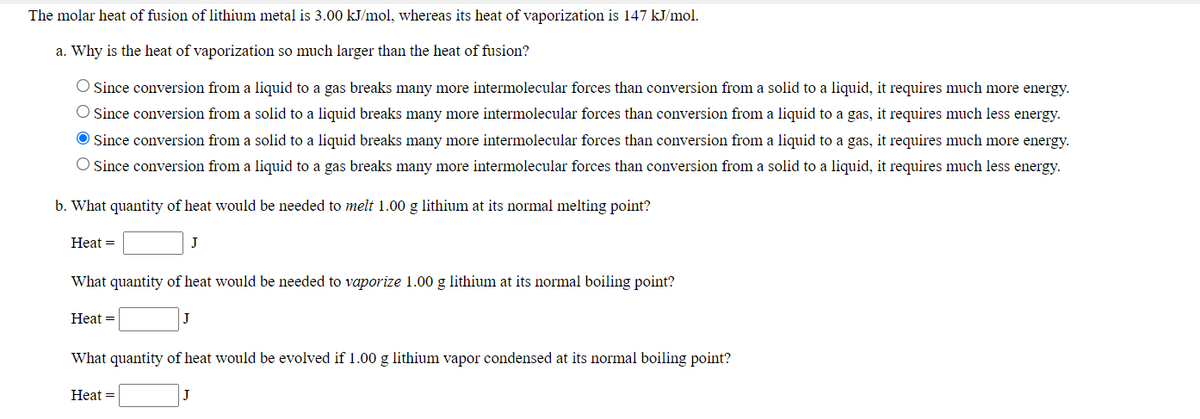The molar heat of fusion of lithium metal is 3.00 kJ/mol, whereas its heat of vaporization is 147 kJ/mol. a. Why is the heat of vaporization so much larger than the heat of fusion? O Since conversion from a liquid to a gas breaks many more intermolecular forces than conversion from a solid to a liquid, it requires much more energy. O Since conversion from a solid to a liquid breaks many more intermolecular forces than conversion from a liquid to a gas, it requires much less energy. O Since conversion from a solid to a liquid breaks many more intermolecular forces than conversion from a liquid to a gas, it requires much more energy. O Since conversion from a liquid to a gas breaks many more intermolecular forces than conversion from a solid to a liquid, it requires much less energy. b. What quantity of heat would be needed to melt 1.00 g lithium at its normal melting point? Нeat - J What quantity of heat would be needed to vaporize 1.00 g lithium at its normal boiling point? Heat = What quantity of heat would be evolved if 1.00 g lithium vapor condensed at its normal boiling point? Heat =
The molar heat of fusion of lithium metal is 3.00 kJ/mol, whereas its heat of vaporization is 147 kJ/mol. a. Why is the heat of vaporization so much larger than the heat of fusion? O Since conversion from a liquid to a gas breaks many more intermolecular forces than conversion from a solid to a liquid, it requires much more energy. O Since conversion from a solid to a liquid breaks many more intermolecular forces than conversion from a liquid to a gas, it requires much less energy. O Since conversion from a solid to a liquid breaks many more intermolecular forces than conversion from a liquid to a gas, it requires much more energy. O Since conversion from a liquid to a gas breaks many more intermolecular forces than conversion from a solid to a liquid, it requires much less energy. b. What quantity of heat would be needed to melt 1.00 g lithium at its normal melting point? Нeat - J What quantity of heat would be needed to vaporize 1.00 g lithium at its normal boiling point? Heat = What quantity of heat would be evolved if 1.00 g lithium vapor condensed at its normal boiling point? Heat =
Chapter10: Liquids And Solids
Section: Chapter Questions
Problem 97E: The molar heat of fusion of sodium metal is 2.60 kJ/mol, whereas its heat of vaporization is 97.0...
Related questions
Question

Transcribed Image Text:The molar heat of fusion of lithium metal is 3.00 kJ/mol, whereas its heat of vaporization is 147 kJ/mol.
a. Why is the heat of vaporization so much larger than the heat of fusion?
Since conversion from a liquid to a gas breaks many more intermolecular forces than conversion from a solid to a liquid, it requires much more energy.
Since conversion from a solid to a liquid breaks many more intermolecular forces than conversion from a liquid to a gas, it requires much less energy.
Since conversion from a solid to a liquid breaks many more intermolecular forces than conversion from a liquid to a gas, it requires much more energy.
O Since conversion from a liquid to a gas breaks many more intermolecular forces than conversion from a solid to a liquid, it requires much less energy.
b. What quantity of heat would be needed to melt 1.00 g lithium at its normal melting point?
Нeat 3D
J
What quantity of heat would be needed to vaporize 1.00 g lithium at its normal boiling point?
Heat =
What quantity of heat would be evolved if 1.00 g lithium vapor condensed at its normal boiling point?
Нeat 3D
J
Expert Solution
This question has been solved!
Explore an expertly crafted, step-by-step solution for a thorough understanding of key concepts.
This is a popular solution!
Trending now
This is a popular solution!
Step by step
Solved in 2 steps with 1 images

Knowledge Booster
Learn more about
Need a deep-dive on the concept behind this application? Look no further. Learn more about this topic, chemistry and related others by exploring similar questions and additional content below.Recommended textbooks for you


Chemistry: An Atoms First Approach
Chemistry
ISBN:
9781305079243
Author:
Steven S. Zumdahl, Susan A. Zumdahl
Publisher:
Cengage Learning

Chemistry
Chemistry
ISBN:
9781305957404
Author:
Steven S. Zumdahl, Susan A. Zumdahl, Donald J. DeCoste
Publisher:
Cengage Learning


Chemistry: An Atoms First Approach
Chemistry
ISBN:
9781305079243
Author:
Steven S. Zumdahl, Susan A. Zumdahl
Publisher:
Cengage Learning

Chemistry
Chemistry
ISBN:
9781305957404
Author:
Steven S. Zumdahl, Susan A. Zumdahl, Donald J. DeCoste
Publisher:
Cengage Learning

General Chemistry - Standalone book (MindTap Cour…
Chemistry
ISBN:
9781305580343
Author:
Steven D. Gammon, Ebbing, Darrell Ebbing, Steven D., Darrell; Gammon, Darrell Ebbing; Steven D. Gammon, Darrell D.; Gammon, Ebbing; Steven D. Gammon; Darrell
Publisher:
Cengage Learning

Chemistry: Principles and Practice
Chemistry
ISBN:
9780534420123
Author:
Daniel L. Reger, Scott R. Goode, David W. Ball, Edward Mercer
Publisher:
Cengage Learning

Chemistry by OpenStax (2015-05-04)
Chemistry
ISBN:
9781938168390
Author:
Klaus Theopold, Richard H Langley, Paul Flowers, William R. Robinson, Mark Blaser
Publisher:
OpenStax